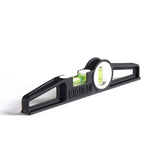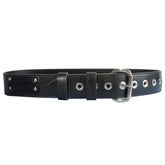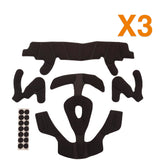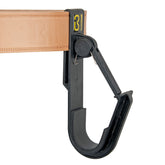Contents
1. Introduction
2. What do the statistics say?
3. Why are the rates so high?
4. The History of Hard Hats.
5. Real-Life Stories
6. Smart Tips When Choosing Your Hard Hat.
7. Why Choose BIGBEN UltraLite?
8. Conclusion
Safety isn’t a place for shortcuts, so when talking about it, honest and straightforward conversations aren’t just important, they’re essential.
So, let’s get real: health and safety is a phrase consistently spoken about (and rightly so!) within all sectors, especially throughout the construction, scaffolding, and offshore industries.
Why is this?
Because the fatal injury rate within construction alone is [1]1.96 per 100,000 workers. This makes it around 4.9 times the all-industry rate, according to the Health and Safety Executive’s (HSE) annual statistics from 2023/2024.
Tragically, 52% of these fatal injuries were due to a fall from a height.
What do the statistics say?
It’s not all doom and gloom, as the Health & Safety Executive’s data from 2023/2024 revealed that accident reduction stagnated. However, it must be noted that injuries and fatalities have risen.
According to Health and Safety International, the fatal injury per [2]100,000 construction workers has also risen by a staggering 78.68% since 2018/2019.
The exacerbation of the injury and fatality rate is putting serious pressure on construction and scaffolding businesses, as well as the wider economy, to keep up with increasing safety demands.
Further statistics recorded by the HSE between [3]2015-2016 shockingly recorded over 7,000 incidents in which workers suffered from a non-fatal injury from falling objects. This resulted in 5,682 employees taking more than seven days off while recovering from the incident. While worker recovery is crucial and absolutely necessary, it’s important to highlight the setbacks it creates for the companies in question.
A 2022/2023 report from the [4]Royal Society for the Prevention of Accidents (RoSPA) revealed that work-related accidents led to 3.7 million working days lost, which consequently resulted in a combined cost of £7.7bn to the U.K.
One factor that is not commonly spoken about, or highlighted in this context, is those within the industry who are self-employed.
Particularly within the construction sector, those who are self-employed face a higher risk of suffering from injuries and fatalities while at work, so much so that the rate of fatalities per [5]100,00 self-employed workers had reached an astounding 3.63 according to 2023/2024 data. This was a 164.23% increase since 2018/2019.
Why are the rates so high?
While the evidence speaks for itself, we must question, 'Why are these statistics spiralling?'
- Falls from Height
The Health and Safety Executive (HSE) revealed that [6]50 workers died due to a fall from height in the U.K. between 2023 and 2024, with these statistics now 35% higher than the previous 5-year average. The statistics are nothing short of devastating, and for many, they may come as a real shock.
Many factors may cause a fall from height, from the cold weather creating brittle or icy surfaces to uneven scaffold boards. Some workers may overlook proper techniques when it comes to using a ladder, or lack of edge protection, and cheap and fragile roof materials are a few causes of falls from roofs. In scaffolding, incorrect assembly, improper use of PPE, or maintenance of a scaffold may lead to a fall, whilst construction workers may suffer from insufficient training, inadequate equipment, or failure to follow health and safety guidance may lead to devastating outcomes.
- Struck by a Moving or Flying Object
The [7]HSE (Health Safety Executive) reported that data from 2016/2017 showed that 137 workers suffered a fatal injury while onsite, with over 20 of them losing their lives due to being struck by a flying or falling object.
Inappropriate or incorrect use of equipment, including machinery such as cranes, can lead to unintentional injury or even fatality to the user or third parties. Dropped tools are also a cause for such catastrophes when working at height.
A 2kg [8](4.4lbs) claw hammer, when dropped from a height of 6 meters (19ft), has an impact of roughly a concrete mixer. A 220g (0.5 lbs) bolt, when dropped from 23 meters (75 ft), would feel similar to the impact of getting hit with a 50kg (110 lbs) cement bag.
- Noise and Vibrations
There’s no denying that sites are bustling, busy, and loud. The variety of tools and machines used today is truly paving the way in modern construction, specifically designed to reduce physical strain, making the tasks at hand faster and easier to complete while maintaining high-quality work.
While these innovations have certainly advanced safer practices for physical health, long-term effects are sometimes overlooked. Conditions like hearing and vision impairments that often emerge later in life can be underestimated, despite their significant impact on quality of life over time.
For example, in a recent survey, it was reported that [9]51% of all workers within construction have been exposed to hazardous noise, with 14% of these workers reported to have hearing difficulty.
The History of Hard Hats
In [10]1919, Edward W. Bullard patented the first hard hat that was appropriately named, ‘The Hard-Boiled Hat’, due to the steam used during the manufacturing process. It was made from steamed canvas, glue, leather brim, and black paint. As a young lieutenant in the U.S. Army’s cavalry during World War I, Edward witnessed firsthand the effectiveness of helmets and realised they could revolutionise safety within the postwar industrial world.

Since then, leaps have been taken to ensure the development of the hard hat, with them officially being made mandatory in the [11]UK in 1990.
Real-Life Stories
Hearing or reading about other real-life experiences that showcase the results of wearing head protection sticks with us.
Why?
Because most of us have felt invincible at some point, falling into the ‘that won’t happen to me’ mindset. But these experiences remind us just how real the risks are.
Since the development of the safety helmet, as we know it today, it has been the reason countless lives have been saved in freak accidents. For example, [12] a young construction worker who was helping to move a large sewer pipe with a pulley suffered a large cut to their forehead and intense pain in their back, leg, and head when the rope snapped, sending the pulley crashing towards them. The heavy equipment came down on their head, but fortunately, the hard hat they were wearing at the time saved them from severe or even fatal injuries.
To put it into perspective, [13] reports from the U.S. in 1970 showed that there were around 15,000 worker deaths. By 2016, that number had dropped to approximately 5200, scarily but powerfully highlighting the effectiveness of head protection.
While it’s incredible to see the positive impact and effectiveness of head protection, there are countless shattering examples of when the outcome has been nothing short of heartbreaking.
In [14]2014, it was reported that 58-year-old Gary Anderson, a native of New Jersey, was delivering some drywall to a high-rise construction site when he was fatally struck by a falling measuring tape. Mr Anderson stopped to speak to another worker when the 1lb measuring tape became dislodged from a worker’s belt that was placed up on the 50th floor. The tape measure began falling at around 140mph before hitting a piece of construction metal and then onto Mr Anderson’s head, who was not wearing a hard hat at the time. Devastatingly, Gary Anderson did not survive his injuries.
A recent report from [15]HSE stated that there was a total of 39 fatal injuries to construction workers recorded between 2020 and 2021, an increase of 8% compared to the 2016-2021 period.
Smart Tips When Choosing Your Hard Hat
Let’s get straight to the point: most helmets look the same, but do not function the same!
At Leach’s, we know that not every job or job site is the same. That’s why our range of head protection is built to match real-world needs, with specific features tailored for different roles and environments. Whether you're on a construction site, scaffolding, or working offshore, there’s a helmet designed to keep you safe and comfortable.
So, what should you keep in mind and look out for when buying a helmet?
- Certified Top & Side Impact Protection
When it comes to head protection, most of us instinctively think about hazards from above—falling tools, debris, or materials dropped from a height. And while top impact protection is vital, it's just one piece of the puzzle. What often gets overlooked is the real and present danger of side impacts, which can cause just as much harm.
“When would this happen?” I can hear you ask.
Take scaffolding work, for example. On a tight, fast-moving site, it's all too easy for a worker carrying a scaffold pole to accidentally turn or move without noticing someone nearby. This sort of impact, without protection, could lead to a very serious outcome.
At Leach’s, we understand that real protection means covering all angles. That’s why our helmet range includes options built to safeguard against both top and side impacts. Whatever your trade or responsibilities, we’re here to help you find the right helmet that works just as hard as you do.
- Types of Standards
You wouldn’t take medication that hasn’t gone through levels of rigorous testing and approved by various boards, so why buy a piece of protective equipment without checking it meets suitable standards?
To meet U.K. standards, a helmet must go through certain tests to ensure it meets the correct level of safety standards, which would make it highly effective in the case of an accident. Testing for impact resistance, penetration resistance, chinstrap strength, and flame-resistance as specified by the BS EN 397 standard.
There are a few key features of BS EN 397, which is the safety standard for industrial helmets. For example, to avoid the risk of strangulation in the event of a fall, the chinstrap strength is less than [16]25kg. Alongside this, its flame-resistant properties mean that the helmet stops burning 5 seconds after the flame is removed.
Another head protection standard is the BS EN 12492. This standard describes the safety requirements for climbing helmets, or helmets intended for working at height. Again, there are a few key features for this standard, such as the chinstrap strength greater than [17]50kg, decreasing the risk of the helmet coming off the user in the event of a fall. There are no flame-retardant properties, but it has a total ventilation area greater than 4cm2.
- Budget or Premium
Of course, we all like a bargain now and then…when it’s appropriate. Bargaining with your life and bargaining for a second-hand mobile phone are two completely different things.
Premium PPE offers superior protection when made from durable and tested materials. This leads to better long-term safety for the worker. However, buying a budgeted option may leave the worker unprotected while performing their tasks and at high risk of injury. This is because the large majority of budgeted products are not made from tough, suitable material, therefore, leaving the worker exposed to all sorts of risks and hazards.
Why Choose BIGBEN UltraLite?
At Leach’s, we have a variety of different brands available that all provide their own key features and benefits. From Pinnacle Zertec to EVO2, a wide options is on hand to ensure that customers can find the ideal helmet for them.
The BIGBEN UltraLite Vented Hi-Vis Height Safety Helmet. This top-of-the-line piece of equipment has several key features to ensure it delivers the ultimate protection for you and your team. Not only does it conform to both EN12492 and EN397 industrial standards for superior shock absorption and penetration resistance, but it also features advanced internal moulding technology. This distributes impact evenly in the event of an accident, preventing the build-up of pressure in one area, which minimises the risk of injury while maintaining the helmet’s strength.
Alongside its durability, this is the lightest height safety helmet on the market, weighing only 417g, allowing you to work comfortably and efficiently, especially during long hours.
There are plenty more features and benefits that have been meticulously designed and executed into the BIGBEN UltraLite Helmet, so much so that it’s changing the game for construction safety. To read further, please visit https://shop.leachs.com/blogs/news/how-the-bigben-ultralite-helmet-is-changing-the-game-for-construction-safety
Conclusion
Over the past few decades, we, as an industry, have made huge strides in reducing injuries and fatalities on-site. However, recent data from the last 10 years reveals a worrying trend: incidents are on the rise again, both in working at height and on the ground. It’s a clear sign that health and safety and PPE need a be made a focal point again.
When it comes to protecting your life, cutting corners just isn’t worth it. Investing a little more in the right helmet could be the smartest decision you ever make.
To see our helmet collection, please visit https://shop.leachs.com/collections/safety-helmets
[3] https://zonesafe.com/working-height-safety-first/
[7] https://zonesafe.com/working-height-safety-first/
[8] https://fallprotectionxs.com/blog-falling-tools-can-be-fatal/
[10] https://www.bullard.com/insights/history-of-the-hard-hat/
[13] https://ohsonline.com/Articles/2019/07/15/Hard-Hat-Saves-Lives-for-100-Years.aspx?Page=1
[15] https://hertstools.co.uk/accidents-in-the-construction-industry-report/
[16] https://cladsafety.co.uk/what-is-the-difference-between-en-397-and-en-12492/
[17] https://cladsafety.co.uk/what-is-the-difference-between-en-397-and-en-12492/





















